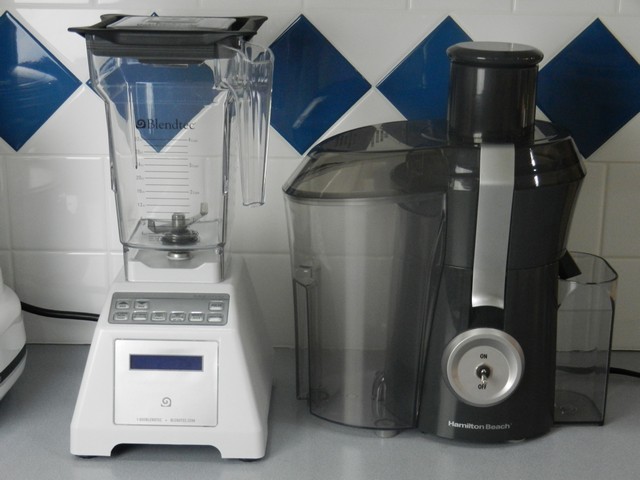
After watching the online documentary movie “Hungry For Change“, we decided to start juicing. We figured juicing would be an easy and convenient way to add more nutrition to our family’s diet. Originally we started juicing by using an extractor juicer. Later we went over to a high performance Blendtec blender instead of the extractor juicer, and have found this to be a much better fit for our family. In my previous post, Making Whole Juice: Vegetables, Fruits, Berries, Recipes, I showed how to use a powerful blender to make whole juices or smoothies from fruits, veggies, berries, and more, and how you can easily come up with your own recipes, or make the drinks different every time by using whatever you have on hand.
We tried two different models of juicers: Breville and Hamilton Beach. In my post Juicers: Comparing Breville to Hamilton Beach , I write about our experience with these two juicers. And in my post Which is Better; Blendtec or Vitamix? Why We Chose Blendtec ,” I compare the two popular and powerful blenders Blendtec, and Vitamix.
In this post, I will compare our experiences with extractor juicers to our blender, and explain why we prefer our Blendtec blender over extractors. On the bottom of this post, you will also find the results of an experiment I did to compare the machines side by side, making juice of carrots and apples.
Here’s my Blendtec, an extremely powerful blender:
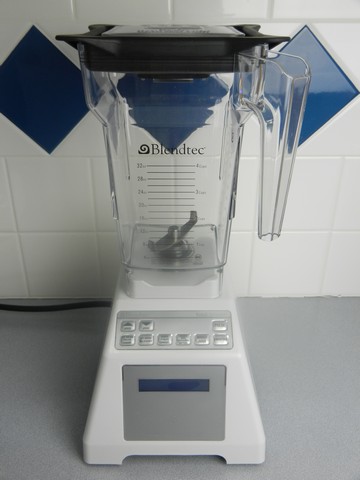
This is my Hamilton Beach extractor juicer, showing the opening where you insert the fruits and veggies; the black item I’m holding is used to push the food down into the machine:
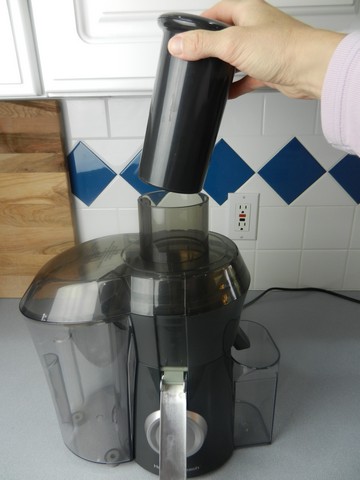
The difference between the two technologies, in a nutshell:
A powerful blender is just that: a powerful blender. It allows you to grind up anything from carrots to ice cubes in order to make juice; this juice will contain all of the parts of the produce you put into the canister, both the nutritious juice and fibrous pulp. Pulp is the dry fiber-parts of produce which does not contain liquids, so this juice will be thick like a smoothie, depending on how much liquid you add to thin it. Some choose to strain it, which would remove the fiber.
Next, a picture of the thick and sturdy blade in the Blendtec:
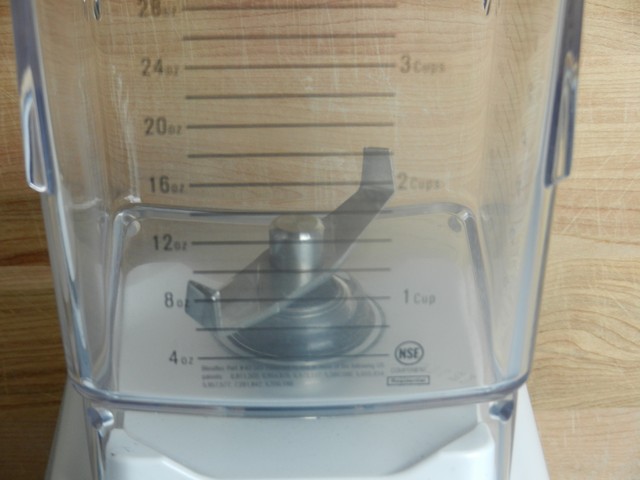
An extractor juicer is a machine that will grind up the produce you put into it, and extract the juice into a container by using a centrifugal (spinning) system, while separating the dry pulp into a different container. The result is a thin juice containing the vitamins and minerals from the produce you used, but no fiber.
Here’s the strainer with tiny shredding knives on the bottom; the sides are full of tiny holes that the juice is strained through before it’s collected:
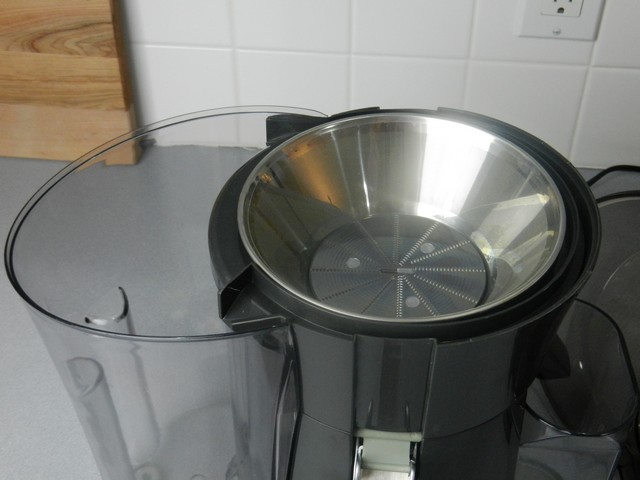
Why we prefer a powerful blender over an extraction juicer / centrifugal system
Pulp / Fiber:
When you remove pulp from juice, you do remove fiber as well. Fiber may not always be needed, but most of us could stand a bit more in our diets in order to function properly and stay healthy. Using a blender keeps the fiber in the juice so that you get the benefit of both the nutritious juice and the fibrous pulp. Pulp also fills you up better, so you can use the juice as a healthy meal replacement now and again. In addition, if you use fruit, the fiber added will help keep your blood sugar levels more even, avoiding the spikes from drinking fruit juice without fiber.
There are times when it makes sense to remove the pulp, however. Let’s say that you need to be on a diet with a high concentration of nutrition, such as part of a cancer recovery plan, when you try to heal and build up your body’s natural defenses. Pulp free means you can take in more juice before getting full, drawing nutrition out of a larger quantity of produce, so you can benefit from more nutritious juice in one sitting. Other people may need a fiber free juice in order to give their digestive systems a break. Fiber free means the nutrition is readily available without fiber to digest first.
I do believe that fiber is essential in itself for most of us, so I prefer a blender that allows you to use pulp in addition to the juice. If using a juicer and discarding the pulp, fiber would need to be added in other ways.
This is what pulp will look like after juicing carrots and apples; the part that I removed from the pulp collector is dryer, and won’t stick to my fingers, and pulp I removed from other parts of the machinery (and therefore didn’t go through as much of the spinning action) still contains some juice, and is stickier:
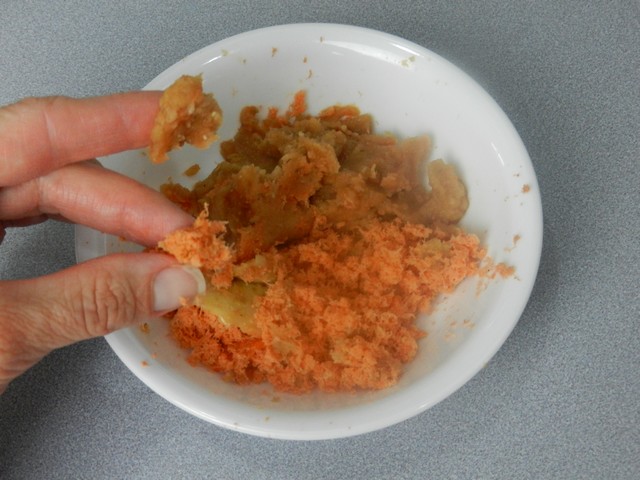
Waste:
Another issue we had with the extractor juicers was the waste involved. When you remove the pulp, just where does that pulp go? In the trash? In the compost? Composting is fine and dandy, but only if you use true waste; otherwise you’re wasting good food. You don’t purchase good apples to throw in the compost, if you know what I mean.
It is said that you can use the separated pulp in recipes, and yes, you sure can. In casseroles, batters etc. Personally I ended up throwing out the vast majority of the pulp from our machine, even though I had the best intentions of using it. I imagine others do the same thing. There are only so many foods you can add pulp to. In my opinion it is, therefore, a money waster in some respects.
Some of the produce we tried through the extractor juicer was nothing but wasteful; I think it was cauliflower that we only got a few drops out of. It was pretty sad to plop it in there, only to see it quickly turn to dust and promptly showed into the pulp compartment, and that was the end of that. Fortunately, many veggies produce a lot more juice than cauliflower does.
In a blender, all the parts you put into the machine will be used, so a blender is very cost efficient.
Mess factor:
The juicer actually made a bit of a mess. Particles of pulp would shoot out of the machine as foods were added, and spray up underneath the cupboards, onto the back splash, and on the surrounding counters. There wasn’t typically a lot of it, but enough that we always had to check and wipe a bit here and there. The blender rarely makes a mess, and if it does, it’s because I waaay overfill it, or I spill while I work.
Cleaning:
One big problem with extractor juicers is cleaning. There are multiple big parts to clean and dry, and it is difficult to remove all the pulp particles from the tiny holes in the basket. The job was tedious enough that we ended up dreading making juice in the first place, knowing the job we were in for after the fact. A juicer is no good if you end up not using it, right?
With the Blendtec blender, cleaning has been amazingly quick and easy! The blades stay right in the container, and most often it is enough to add hot water and a drop of dish liquid to the canister, blend it, rinse, and you’re done. The Vitamix blender cleans the same way.
This is the amount of parts from the Blendtec, and the space they take while drying on the counter:
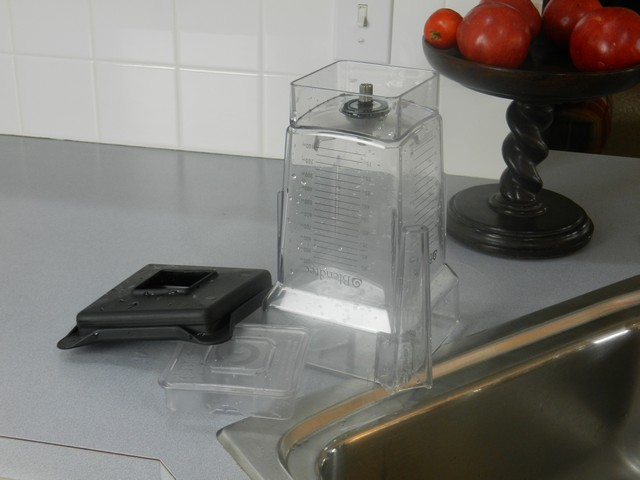
This is the amount of parts from the Hamilton Beach juicer, and the space they take while drying on the counter; this assumes you use a bag in the pulp container. If not, this container will need to be cleaned as well:
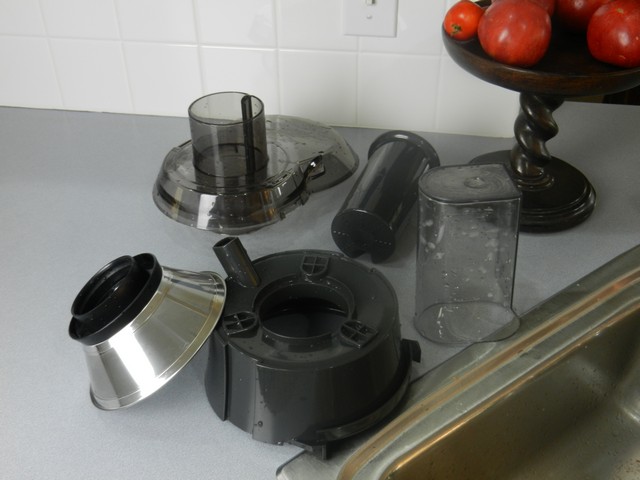
To save space on my counters, I will often let the parts air dry like this:
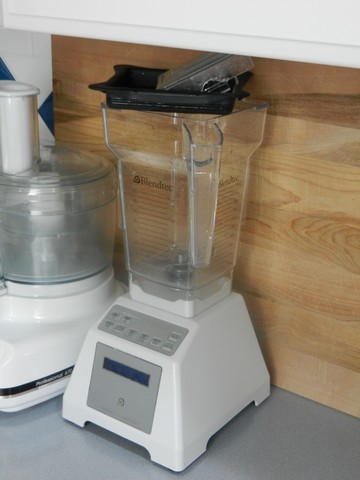
For the juicer, I did this (a bit harder to stack, but it worked):
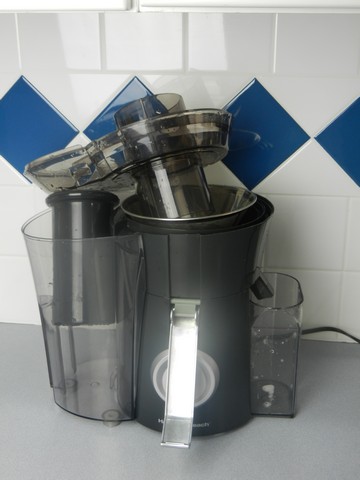
Why not just eat the veggies as is, instead of juicing?
Well, It’s pretty simple, really: We don’t. Most of us won’t eat nearly what we know we ought to. You probably know what I mean. It takes time to eat raw, and veggies are rarely very high on our lists of “foods I love”. Take kale, for instance; as nutritious as it is, the flavor is very strong, and few people enjoy eating it, plain or otherwise. In juice, however, you can mask the flavor and easily get a helping of it in an enjoyable way. Fruits and mild tasting vegetables will help mask the flavor and sweeten things up. You could always add some banana to it as well.
Another piece of info I’d like to share with you: Juice and smoothies should be “chewed” in order to stimulate saliva production for the sake of the enzymes this will add. Chewing can also stimulate a bowel movement, even if no fiber was added.
Testing juicer and blender, side by side:
I performed a simple test of making juice from carrots and apples, using both machines side by side. Apples and carrots were of equal amount by weight, before preparing for juicing:
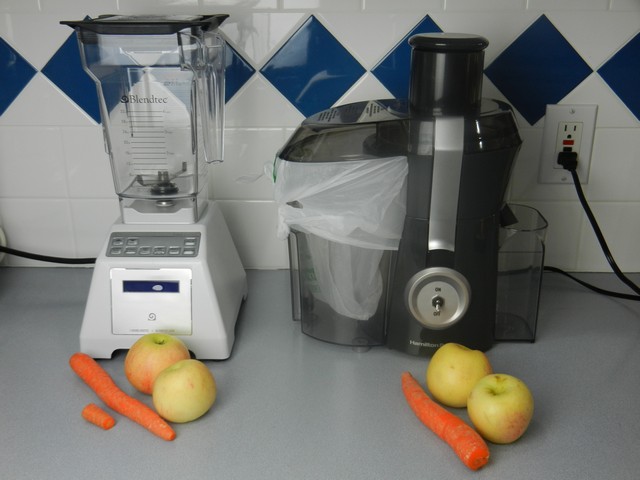
In extractor juicers (to the right), the produce can often go into the machine whole, or cut in large chunks just to fit through the opening. Little preparation is needed. In blenders, you have to remember that everything you put in there will stay in your juice, so certain parts, like apple cores, will need to be removed.
I rinsed everything, removed the apple cores for the blender portion, and cut the carrots in thirds. Then I ran apples and carrots through the machines.
The next picture was taken after juicing. For my blender, I also added 1/2 c water, otherwise the juice would have been too thick:
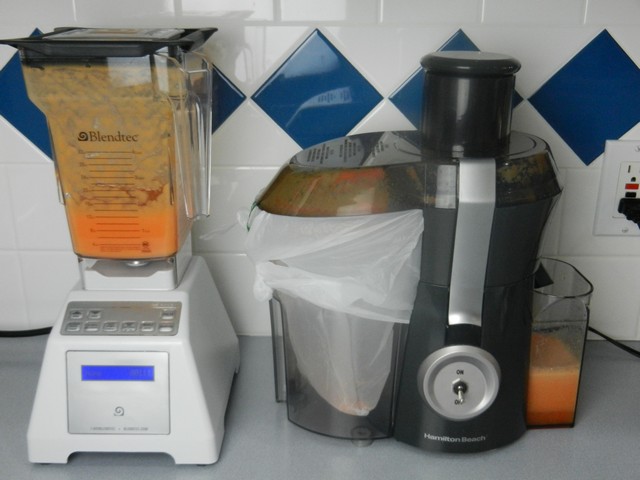
These are the end products: Juice in the glasses, and waste in the bowls. For the blender (LEFT), I cut out the apple cores, otherwise all parts were used and still in the juice, including fiber. For the extractor juicer (RIGHT), the pulp was separated from the juice, and I placed it in the bowl for you to see. That means all fiber has been removed from the juice. This juice is thin, while the juice from the blender is thick, even with the water added.
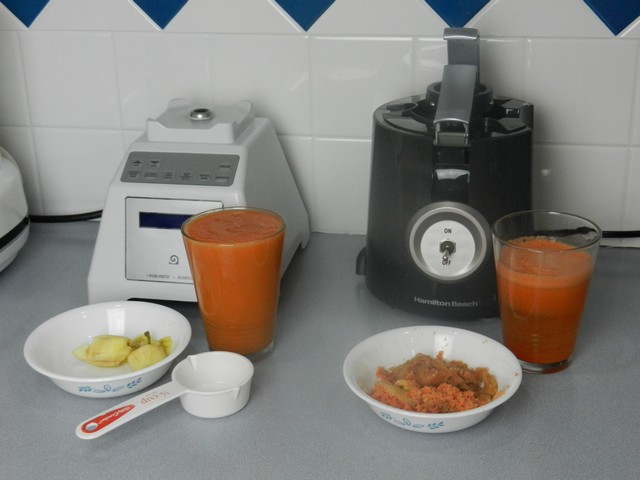
Blender juice, waste, and parts to clean:
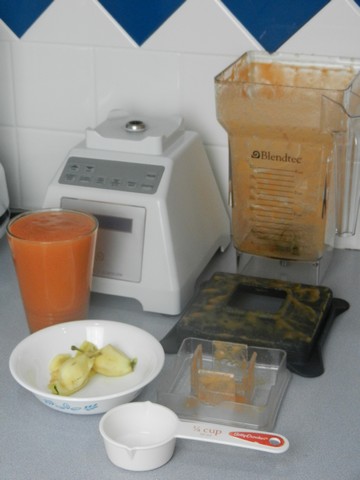
Extractor juice, waste, and parts to clean (except for large canister in the back to the left, since I used a bag to catch the pulp); the top of the machine comes off and needs cleaning as well:
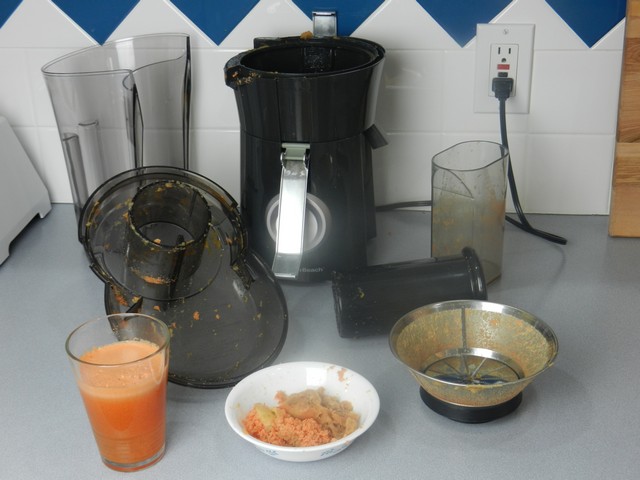
The juice from the extractor juicer separates as it sits, which is interesting to watch. The longer it sits, the more it separates. You just stir it up again before you drink it.
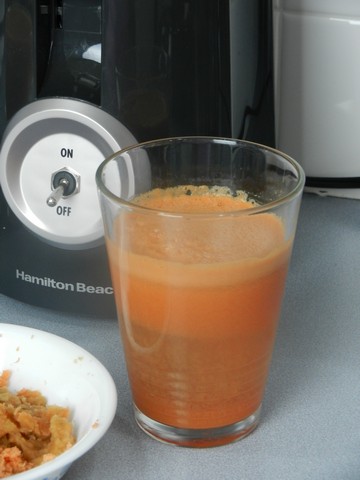
Both ways of juicing will add valuable nutrition to your diet. Which method is better? Well, it definitely is a personal preference, but the Blendtec blender is clearly my choice.
Look out for my next posts, where I will compare two extractor juicers; Breville, and Hamilton Beach, and also touch on why we chose the Blendtec blender over Vitamix (click Which is Better; Blendtec or Vitamix? Why We Chose Blendtec.)
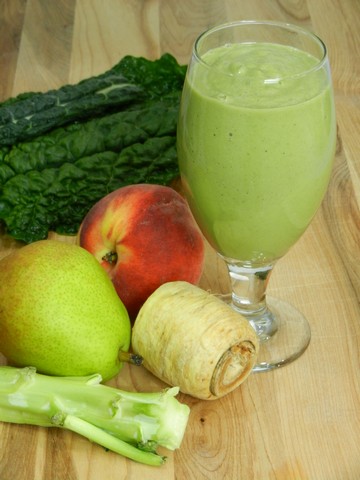
I enjoyed reading your article, Terese! Terry has to be on a strict diet to avoid swelling and pain throughout his body. He has been wondering about a juicer, but I think I will take your advice and stick with our blender. Thank you for all the info you gave, it was very interesting and helpful!
Thanks for commenting, I’m glad you found it helpful! So sorry he’s struggling with these symptoms, sounds awful! Hope your blender will prove to be a real blessing to your family!
I am used to juicing with blenders where i normally will add water. I have just purchased a Milex juice extractor, but my difficulty is that Do I use water when ectracting juice or not.? Please your help will be much appreciated.
No, you will not add water while extracting the juice, but you can add some afterward if desired. I would not, you’ll just dilute the flavors. Extra water is not necessary unless the flavor is too strong. This juice will not be thick like smoothies in a blender. HTH!
this was a fabulous write up and very helpful, thank you for the pictures and the side by side. I appreciate your efforts and information given. very informative and helpful. thanks, Tammara
I’m glad you found it helpful! Good to hear.
This is the best review/explanation comparing juicers and blenders that I have come across. Thank you.
That’s very nice to hear! Thanks for your comment! I do put a lot of effort into my posts, and it’s quite time consuming altogether. So I appreciate the feedback!
Thank you very much. This article was very interesting and informative.
Wonderful article – very well written and informative. So glad I read it before splashing money on fancy equipment.
Just a quick question: my main goal is to drink the juice of beetroot. Since this is a very hard veggie, will a blender’s blade be able to handle it to make juice from?
Thanks again.
Chris
Thank you! I’m glad I could help!
You should definitely be able to blend hard veggies like these, but you may need to add some liquid to it to keep it moving. Otherwise, if the blended food becomes too thick and dry, sometimes the mass will stick to the sides and the blades will spin around with nothing around them. Try it, but have some water, juice, or some softer fruits /veggies handy to add to keep it liquid enough to circulate. I can almost guarantee that you’ll have to add a liquid. That’s one benefit to a juicer, you don’t have to add extra liquids.
This is a wonderful article, so informative and interesting to read!
Thank you for all the tips and photos you gave along the way I’m excited to start juicing now 🙂
Thanks for your comment, I’m glad I could help! Happy Juicing! 🙂
I use nutrabullet to juice breakfast (spinach cucumber
Squash pumpkin seeds almond milk.
Can i add uncooked steel oats?4
Seems like you could, at least a little bit. I’ve never tried it, though.
I thought this was a great article, thank you. I agree that consuming healthy nutrition through blending and nutrition extractors is a great way to improve health. I suffered inflammation in my joints and used a Nutri Pro machine to make 2 anti inflammatory drink a day. One in the morning and one before bed. It did wonders for my pain, better than any medication. Just have to stick with it! If anyone hasn’t seen the nutri pro machine I would recommend it and it was priced ok too. Here it is, it helped me a lot http://www.nutripro.com.au
Thanks so much for the informative review. I’ve owned my Blendtec blender for over a year now and haven’t really put it to work until reading your review last week. I’ve been throwing in whatever is in the crisper and have made some pretty outstanding whole juices. I love the fact that I can place and entire lemon or lime into the mix peel and all (I quarter them) and still get a great smooth juice. I’m having fun with my kitchen toy and feel better for it already. I’m still eating meals but since I started juicing I eat much smaller portions and make healthier choices for my meals. Like many people in my age group (50+) I’ve started to develop some aches and pains and I do believe it is partially due to my flailing diet…..I’m excited to find out if that is in fact the case and to confirm that I can remove the rust from my joints by adopting a more vegetable and fruit based diet. I’ll keep in touch!
Lana
I’m glad I could be an inspiration through my post! It’s never too late to make positive changes, good for you! And thank you for commenting!
I use an Omega VSJ843 cold-press juicer and both a Nutri Ninja and an Oster Pro 1200 for blending. For me, I juice my vegetables and blend my fruits and protein powders. I do, however, juice apples along with carrots in the juicer. By juicing vegetables but blending fruits, I enjoy the mega nutrition from the vegetable juice along with the fiber from the fruits. By the way, the VSJ843 (VSJ stands for “very slow juicer”) practically cleans itself, and the 43 revolutions per minute of the auger versus the 10,000 RPM baskets of the centrifugal juicers means far less oxidation of the veggies and just about the same juice quantity (or more) as compared to the centrifugal juicers. I hope my comments are helpful.
Thank you very much, yes, your comment is very helpful and informative! I appreciate that you took the time to explain these things. Interesting concept to use a juicer for veggies and blender for fruits, great idea!
Thank you so very much for taking the time to write such a thoughtful and informative review and to include photos. This appears to be unbiased and not sponsored, which is nice. You really explained everything clearly and in an organized way and addressed so many common concerns. Fantastic job! 👏💯
Oh awesome, this comment means so much to me! I have put so many hours and days into each of my blog posts, so it’s wonderful to get this type of feedback. And yes, completely unbiased, nobody paid me a penny for this review or to recommend one over another. I was simply wanting to get to the bottom of it for my own sake. But when I learn valuable information I figure it’s important to share so others can make a more informed decision for themselves. I also appreciate the information other people share that helps me along when I need a little assistance, so this is one way for me to contribute and help others in return.
Thank you again for your comment, it means so much to me!
Thnk yiu